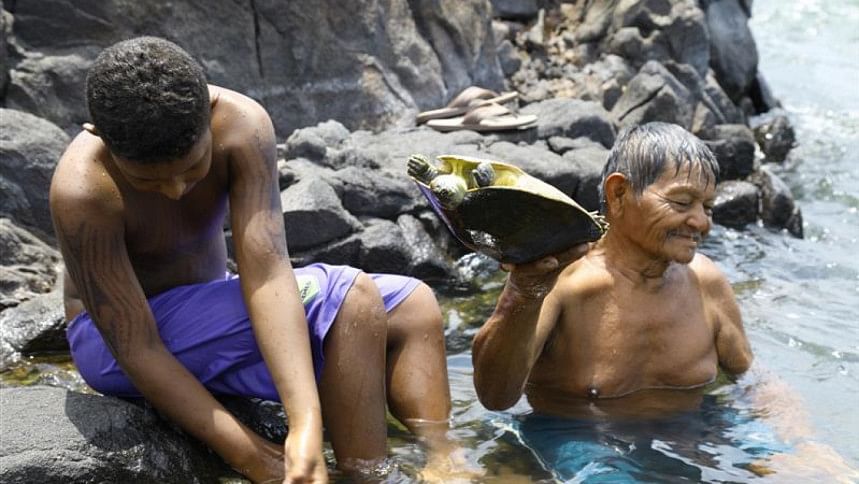Amazon hydropower: Brazil's 'people of the river' pay the price

The waters of the Xingu River below the Belo Monte hydropower dam, in Brazil's Amazon, used to flood the river's forested islands during the rainy season, allowing fish to glide among the trees and gorge on fallen fruit.
But since the controversial dam opened six years ago, the forests no longer flood consistently, and the fish have lost a key place to feed and spawn, local people say.
"Today, these fruits all fall onto dry land, so the fish can't get the food," said Josiel Pereira, an indigenous Juruna man from the village of Miratu, in Para state.
During the dry season, in turn, the dam sometimes releases too much water at once, drowning sandy beaches and destroying the nests where turtles have long laid their eggs, said Pereira, who is helping scientists understand the ecological impacts of the dam's construction.
"It has been very difficult for us to survive after the Belo Monte dam development," he said in an interview. "It has caused a lot of impact on our food, on our source of income."
Estimated to cost at least 40 billion Brazilian real ($7.6 billion), the Belo Monte hydroelectric complex, the world's fourth biggest hydropower dam, includes a main dam called Pimental and the Belo Monte reservoir.
Harnessing the waters of the Xingu, the dam generated about 5% of all of Brazil's electricity last year, according to its operator Norte Energia.
But the huge dam complex, vigorously opposed by many indigenous groups in the Amazon, is also changing age-old patterns of seasonally rising and falling water downstream, disrupting the balance of nature and the lives of people who depend on it, scientists and residents warn.
"I feel sad because before I could earn my living, my family's living, by fishing," said Pedro Viana, 51, as he sat on the prow of a boat, trailing a fishing net in the abrupt turn in the Xingu known as the Volta Grande, or "Big Bend", a 130-km (80-mile) stretch of river downstream from the Belo Monte.
"Nowadays, I have to survive by selling farina (manioc flour) and bananas," said Viana, a member of the local Juruna indigenous community.
FEWER FISH
Researchers and indigenous advocacy groups say the Belo Monte complex's main Pimental dam blocks about 80% of the Xingu's water, sending it through an artificial channel that feeds the power station.
Currently, the dam sends a maximum of 4,000 or 8,000 cubic meters of water downstream per second in the wet season - the amount alternates each year - and 700 cubic meters in the dry season, according to Norte Energia.
But locals and researchers say that is a fraction of historical water release levels. That has prompted Brazil's environmental agency Ibama to ask for new studies into the impacts of the dam's water release levels.
A May 2022 report by researchers from the United States and Brazil, partly funded by Norte Energia, found a nearly 30% reduction in fish species' "richness, abundance, and functional diversity" and an overall drop in fish sizes in the Volta Grande as a result of the Belo Monte complex's construction.
Norte Energia has come up with proposals to adjust the amount of water it releases each season, to be considered by the federal prosecutor's office, which in the past has filed several lawsuits against the company for environmental damage caused by the construction of the dam.
In a statement, Norte Energia said the amounts of water allocated below the Pimental dam were intended to "ensure the ecological conditions of the Big Bend" and create flows that "simulate the natural pulse of the Xingu River."
In particular, the periods of lowest water release were not below naturally occurring levels in some years, it said.
But Andre Oliveira Sawakuchi, an associate professor at the University of Sao Paulo's Institute of Geosciences and an expert who has studied the area for more than a decade, disagrees.
The Volta Grande's colossal water discharge and granite rock base had created, over time, an ecosystem of forested islands in the river which have adapted to the seasonal ebb and flow of the river, Oliveira Sawakuchi said.
"Here, we have a forest inside the river. This is very particular and unique," he said.
But the dam's engineering has caused a "total disruption of this ecosystem. It's not possible to keep both things working completely - energy production and the ecosystem," he added. The Juruna people have joined with scientists and the Brazilian nonprofit Socioenvironmental Institute, or ISA, to propose an alternate plan for water releases from the Pimental dam that would provide more water for themselves and nature.
Their counter-proposal is expected to be considered by the federal prosecutor next month, alongside the company's.
SACRED SPACE
Around the Volta Grande there are already high-water marks exposed on boulders, wide sand dunes along the shores and new islands in the stream - all land that had been previously underwater.
The Juruna - who call themselves the "people of the river" - say the changes are worrying for communities that have since time immemorial depended on the river for navigation, fish, and water for drinking, cooking and bathing.
For the Juruna, a confluence of low waterfalls and rapids called Jericoa in the Volta Grande is a sacred place. Whitewater cascades create swirling eddies in the river, which they navigate with ease in wooden canoes or skiffs.
Wearing a traditional headdress of blue and red macaw feathers ringed with white plumes, Giliarde Juruna, 40, chief of Mïratu village, rued the threats facing his people.
He said former Juruna leaders had been tricked by Norte Energia into accepting environmental and financial pledges that the company failed to live up to.
"They promised us we would have energy for free," he said. But at about 500 real a month per household, the electricity generated by the dam costs more than most in the community can afford, he complained.
In a statement, the company said it had carried out "more than 100 socio-environmental projects" in the Volta Grande since 2011, complying with an agreement with Ibama.
These include installing fish farms and cocoa plantations and bringing potable water access, sanitation and sewage systems to riverside communities, as well as providing healthcare access to families in the "dam's area of influence".
Local people say those changes do little to benefit them.
In Miratu, Josiel Pereira pointed to dead fish floating in one of the fish farms. He said the fish were an introduced species that were not well adapted to the area, unlike the once-abundant native species like pacu. Without enough fish in the Xingu, Silvia Da Cruiz, an indigenous mother of four in Miratu, said she has to buy meat, chicken and processed foods to feed her family, raising the cost of living and forcing families like hers into the cash economy.
"It's not true that Belo Monte dam's energy is clean," said Mariel Nakane, an economist working with ISA. "(Brazilians) are paying less for the hydroelectric power energy… but the costs are here on the people who live in the Volta Grande."
Originally published on: https://www.context.news/nature/brazils-people-of-the-river-pay-price-for-amazon-hydropower

 For all latest news, follow The Daily Star's Google News channel.
For all latest news, follow The Daily Star's Google News channel. 



Comments